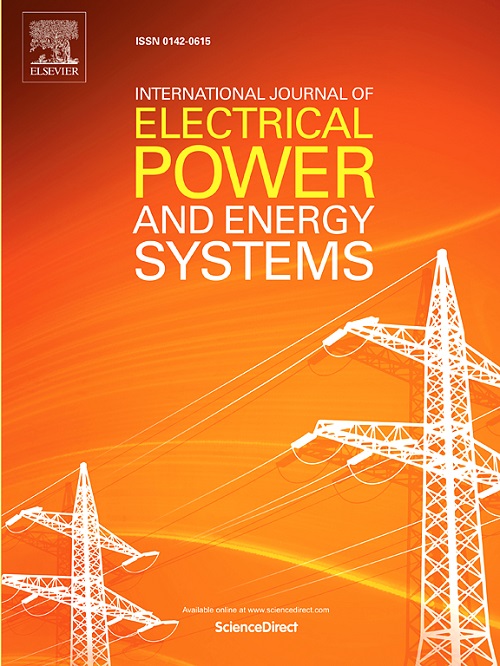基于最大功率精确估计的风电场精确减载优化策略
IF 5
2区 工程技术
Q1 ENGINEERING, ELECTRICAL & ELECTRONIC
International Journal of Electrical Power & Energy Systems
Pub Date : 2025-04-10
DOI:10.1016/j.ijepes.2025.110659
引用次数: 0
摘要
为缓解日益增加的电网调频压力,风电场必须从传统的最大功率点跟踪模式向减载模式转变。由于尾迹效应,风电机组在卸载过程中运行状态的变化将直接影响下游风电机组的输出。然而,现有的降载策略仍然采用传统的最大功率点保守估计风电场的最大功率,忽略了尾迹效应带来的潜在发电能力,将其作为降载的基线功率。这将导致风电场的实际减载比超过电网需求,即过度减载,不利于经济运行。因此,为了实现更精确的降噪,本文首先结合风力机的关键参数——转子转速和俯仰角,构建考虑尾迹效应影响的风电功率分析灵敏度模型。在此基础上,分析各风力机使风电场出力最大化的工作点,该工作点由于尾迹效应不再是最大功率点。在此基础上,提出了一种风电场最大功率估计方法,并以该最大功率为基准设计了精确的卸载策略。该策略在精确满足电网负荷需求的同时,进一步提高了风电场的发电效率。最后,基于SimWindFarm仿真验证了该方法的有效性和先进性。本文章由计算机程序翻译,如有差异,请以英文原文为准。
Precise deloading optimization strategy for wind farm based on the accurate estimation of maximum power
To alleviate the increasing pressure of frequency regulation on the power grid, wind farms must shift from the traditional maximum power point tracking mode to the deloading mode. Due to the wake effect, the change of the operating state during the wind turbine deloading will directly affect the output of the downstream wind turbine. However, existing deloading strategies still conservatively estimate the maximum power of the wind farm using traditional maximum power point, which ignores the potential power generation capacity caused by the wake effect, and uses it as the baseline power for deloading. This will result in the actual deloading ratio of the wind farm exceeding the grid demand, i.e., excessive deloading, which is adverse to the economic operation. Therefore, to achieve more precise deloading, this paper first combines the key parameters of wind turbine – the rotor speed and pitch angle, and constructs a wind power analysis sensitivity model considering the influence of the wake effect. On this basis, the operating point of each wind turbine that maximizes the wind farm output is analyzed, which is no longer the maximum power point due to the wake effect. Further, a maximum power estimation method for wind farm is proposed, and a precise deloading strategy is designed using this maximum power as the baseline. This strategy further improves the power generation efficiency of the wind farm while precisely meeting the deloading demand of the grid. Finally, the effectiveness and advancement of the proposed method are verified based on SimWindFarm simulation.
求助全文
通过发布文献求助,成功后即可免费获取论文全文。
去求助
来源期刊
CiteScore
12.10
自引率
17.30%
发文量
1022
审稿时长
51 days
期刊介绍:
The journal covers theoretical developments in electrical power and energy systems and their applications. The coverage embraces: generation and network planning; reliability; long and short term operation; expert systems; neural networks; object oriented systems; system control centres; database and information systems; stock and parameter estimation; system security and adequacy; network theory, modelling and computation; small and large system dynamics; dynamic model identification; on-line control including load and switching control; protection; distribution systems; energy economics; impact of non-conventional systems; and man-machine interfaces.
As well as original research papers, the journal publishes short contributions, book reviews and conference reports. All papers are peer-reviewed by at least two referees.

 求助内容:
求助内容: 应助结果提醒方式:
应助结果提醒方式:


